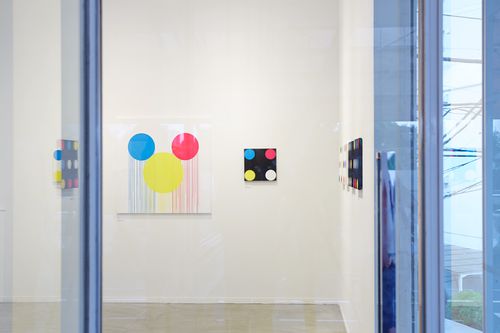Made in Tokyo
8.21 - 9.2, 2015 Gallery Speak For
目次
Concept
Note : MADE IN TOKYO (en)
The title “MADE IN TOKYO” occurred to me as I was sitting in a taxi, attempting to escape Tokyo’s Shibuya disctrict one midnight. The concepts, compositions, coloring and motifs of my work which had been so tangled, suddently snapped into one single, unified thread. My roots lie in 1990s Tokyo. The subculture known as “Shibuya-kei” which produced musicians such as Flipper’s Guitar, Pizzicato Five and Towa Tei, and graphic designers like Comtemporary Production and Groovisions, were incorporating influences from America, England and France. These artists took foreign styles and trends and reproduced them with a polished superficiality, with an emphasis on technical mastery and catchiness rather than pure originality. At that time, after viewing a large Andy Warhol exhibition in 1996, I began to devote myself to art. I was consumed by the works of Marcel Duchamp, Jasper Johns, Jeff Koons, Ed Ruscha and of course Warhol. Ready-made, replicated, and even stolen art was popularized in the form of Appropriation, Assemblage, simulation and overpainting. Upon reading Jean Baudrillard’s “Simulacra and Simulation” I was surpised at how closely Simulationist ideas paralleled the lack of pure originality I felt having grown up in Tokyo. 1980s Simulationist artist Mike Bidlo took the works of Picasso, Matisse, Duchamp and Warhol and copied them wholesale - titling his works “Not Picasso”, “Not Warhol” etc. he exhibited perfectly replicated works as his own. Bidlo’s audacious coopting of other artists’ work created a complete denial of pure originality. In creating “MADE IN TOKYO”, I wanted to further explore that denial, and exhibit the masterpeices of those artists as though they were products of Tokyo. This brand of assimilation has a strong history in Tokyo - most notaby from 1868, in which the Edo period gave way to Meiji and ushered in a massive influx of European culture - thus leading the capital city to became a place of institutionalized simulacra. Likewise, I wanted to take my influences from the 90s and bring them into the world of contemporary art. “MADE IN TOKYO” uses sampling, remixing, and mashups to express the intersection of originality and simulacra.
Note : MADE IN TOKYO (ja)
帰り道、渋谷を抜ける時ふと「MADE IN TOKYO」のアイデアが浮かんだ。複雑に絡み合っていた糸がぴんと張り、線が見えた気分だった。構図・コンセプト・色彩・モチーフがひとつになったのだ。90年代の東京、それが私のルーツなのだ。 フリッパーズ・ギター、ピチカート・ファイヴ、テイ・トウワ。グラフィックの領域ではコンテムポラリー・プロダクション、グルーヴィジョンズ、渋谷系と呼ばれたムーブメントは、アメリカ、 イギリス、フランスをはじめ世界中の音楽やデザインを呑み込んでいった。彼らはファッション的に海外のトレンドのいいとこどりをし、表面的なキャッチーさと職人的なテクニックを駆使した作品を生み出していったのだ。 同じ時期、1996年に開かれたアンディウォーホルの回顧展をきっかけに私はアートに没頭していった。マルセルデュシャン、ジャスパージョーンズ、アンディウォーホル、ジェフクーンズ、エドルシェ… 、レディメイド、アプロプリエーション、アッセンブラージュ、シミュレーション、オーバーペイントの手法。アーティストは筆を 捨て、作ることをやめ、自己の存在をも否定しながら20世紀の美意識を模索していた。特にアメリカを中心に起きた80年代のシミュレーショニズムとジャン・ボードリヤールによる著書 「シミュラークル(オリジナルなき模倣)とシミュレーション」は、東京で育った自分のあまりにも希薄なバックグラウンドと驚くほど共感するものがあった。80年代のシミュレーショニストのマイクビドロは、ピカソ、マティス、デュシャン、ウォーホルなどの模写を一同に配置し、他人の絵を狂気のように再現し続けたアーティストだ。ビドロは自分自身の存在を極限まで喪失させていった。私はその否定の先にあるアイデンティティを模索している。 東京は、1868年(明治元年)にヨーロッパの文化を吸収しようと生まれた巨大シミュラークルだ。私は自分自身が受けた影響をそのまま、現代アートのシーンに放り込んでみたいと考えている。「MADE IN TOKYO」は、サンプリング、リミックス、マッシュアップの手法を使い、シミュラークルに潜むアイデンティティを表現しようとしている。
July, 2015 Masato Yamaguchi
Interview
「渋谷系」と「日本」のもの作りの共通点 信藤三雄×山口真人 (Japanese only)














